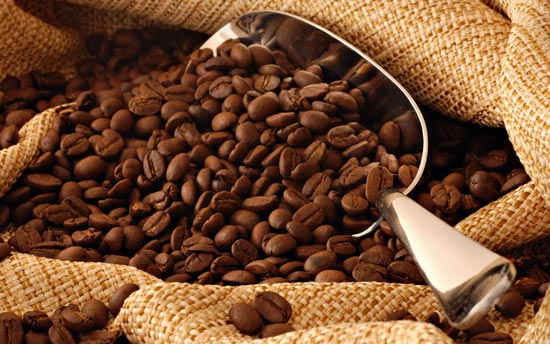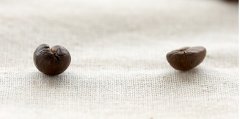Boutique Coffee-Hawaiian Kona Coffee how to make Hawaiian Kona Coffee
Hawaii, a beautiful tropical Pacific island, not only produces beautiful scenery, but also produces the famous Kona coffee. Kona is also named after origin and can be sold under the trademark Kona only on the southwest coast of Hawaii, 20 miles long and 2 miles wide, 150m to 750m above sea level, covering the slopes of Hualalai and MaunaLoa volcanoes.
Kona coffee, Arabica, beautiful appearance, average neat bean shape, clear taste, medium mellow, slightly sour taste, strong aroma and long aftertaste. Kona coffee is divided into four grades, namely ExtraFancy,Fancy,Prime and Gr.No.1. Due to low production and high production costs, in the case of increasing demand for boutique coffee, the price of Kona on the market is catching up with the Blue Mountain of Jamaica, and the best Kona beans are becoming more and more difficult to buy.
The excellent quality of Kona coffee benefits from the suitable geographical location and climate. Coffee trees grow on the slopes of volcanoes and the volcanic ash soil is fertile. The climate is suitable, the sun in the morning gently passes through the air full of water vapor, in the afternoon, the mountains will become more humid and foggy, the white clouds surging in the air are natural umbrellas for coffee trees, and the evening will become sunny and cool, but there is no Frosts Descent. Because of the suitable natural conditions, the average yield of Kona coffee is very high, reaching 2240 kg per hectare, while in Latin America, the yield of coffee per hectare is only 600kg ~ 900kg.
The raw beans of Kona coffee are usually small packaged coffee beans. Kona coffee is also often used to make blended coffee along with other coffee beans. Kona beans mixed with other beans will be marked with "KonaBlend" on the package. Unfortunately, the content of Kona beans in this mixed bean may be very low, and the minimum content of Kona beans in Hawaii that can use the "Kona" label is only 10%.
The smell of Hawaii
In Hawaii, you can watch the fiery sunset sink into the red-orange sea, feel the fresh air filled with the scent of flowers, and sit by the sea and drink a cup of Kona coffee. I'm afraid there is no place in the world that can offer you such enjoyment.
The earliest settlers in Hawaii arrived here between 300 and 400 AD, and historians speculated that they were from the Marcos Islands. People are scattered into different tribes that live on the island and are led by hereditary chiefs. The earliest Hawaiian residents created the rich musical culture of Hawaii, although not many words have been preserved.
Europeans discovered Hawaii by accident. They were looking for a legendary passage to the east where spices were produced, but they found the richest pearl in the Pacific Ocean. A captain named James Cook landed at Kauai in 1778 to resupply his ship. He encountered severe cold and storms on his way back, so he had to return to Hawaii at the beginning of the next year and anchor on a beach in Kona. Since then, the Hawaiian islands have become an important port of call on world trade voyages. The chiefs of Hawaii exchanged sandalwood, the island's specialty, for weapons, goods and livestock with passing ships. From the 1820s, Western religion began to spread widely on the island, and many churches built at that time are still in use today.

Important Notice :
前街咖啡 FrontStreet Coffee has moved to new addredd:
FrontStreet Coffee Address: 315,Donghua East Road,GuangZhou
Tel:020 38364473
- Prev

Guatemala Antigua coffee beans imported sour China Coffee Network
Guatemala: Antigua coffee flavor taste characteristics: rich, rich taste, with tobacco flavor. Antigua coffee from Guatemala must be on the menu of some upscale cafes. People who like it always keep in mind its special smoke smell. Coffee has created prosperity for Guatemala. To this day, coffee is still affecting
- Next

Colombian coffee beans Arabica coffee beans roasted
Colombian coffee (Cafe de Colombia), which originated in Colombia, is one of the few individual coffees sold in the world under the name of the country. In terms of quality, it has won praise unmatched by other coffee. Compared with other producing countries, Colombia is more concerned with developing products and promoting production. It is this, coupled with its superior geographical and climatic conditions, that makes Goran
Related
- Does Rose Summer choose Blue, Green or Red? Detailed explanation of Rose Summer Coffee plots and Classification in Panamanian Jade Manor
- What is the difference between the origin, producing area, processing plant, cooperative and manor of coffee beans?
- How fine does the espresso powder fit? how to grind the espresso?
- Sca coffee roasting degree color card coffee roasting degree 8 roasting color values what do you mean?
- The practice of lattes: how to make lattes at home
- Introduction to Indonesian Fine Coffee beans-- Java Coffee producing area of Indonesian Arabica Coffee
- How much will the flavor of light and medium roasted rose summer be expressed? What baking level is rose summer suitable for?
- Introduction to the characteristics of washing, sun-drying or wet-planing coffee commonly used in Mantenin, Indonesia
- Price characteristics of Arabica Coffee Bean Starbucks introduction to Manning Coffee Bean Taste producing area Variety Manor
- What is the authentic Yega flavor? What are the flavor characteristics of the really excellent Yejasuffi coffee beans?

